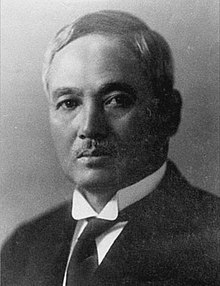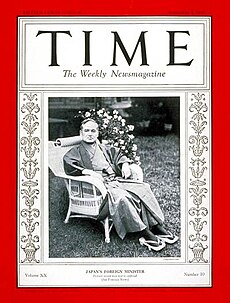Uchida Kōsai: Difference between revisions
m interwiki : ar |
mNo edit summary |
||
| Line 24: | Line 24: | ||
==Biography== |
==Biography== |
||
| ⚫ | |||
Uchida was born in what is now [[Yatsushiro, Kumamoto|Yatsushiro city]], [[Kumamoto Prefecture]], as the son of the domain's doctor. After studying [[English language|English]] for two years at [[Doshisha University]], Uchida moved to [[Tokyo Imperial University]], graduating from its law school. |
Uchida was born in what is now [[Yatsushiro, Kumamoto|Yatsushiro city]], [[Kumamoto Prefecture]], as the son of the domain's doctor. After studying [[English language|English]] for two years at [[Doshisha University]], Uchida moved to [[Tokyo Imperial University]], graduating from its law school. |
||
| Line 31: | Line 33: | ||
He was appointed to the [[House of Peers]] in the [[Diet of Japan]] in 1930, and became President of the [[South Manchuria Railway Company]] in 1931. |
He was appointed to the [[House of Peers]] in the [[Diet of Japan]] in 1930, and became President of the [[South Manchuria Railway Company]] in 1931. |
||
| ⚫ | |||
Under his third term as Foreign Minister, from 1932 to 1933, during the [[Saito Makoto]] administration, he called for the formal [[diplomatic recognition]] of [[Manchukuo]], and later called for Japan's withdrawal from the [[League of Nations]]. He was featured on the cover of [[Time Magazine]], September 5, 1932 edition, which also contained an article on his stance vis-à-vis the League of Nations. He died of illness 15 days after the [[February 26 Incident]]. His grave is at the Tama Reien at Fuchu, Tokyo. |
Under his third term as Foreign Minister, from 1932 to 1933, during the [[Saito Makoto]] administration, he called for the formal [[diplomatic recognition]] of [[Manchukuo]], and later called for Japan's withdrawal from the [[League of Nations]]. He was featured on the cover of [[Time Magazine]], September 5, 1932 edition, which also contained an article on his stance vis-à-vis the League of Nations. He died of illness 15 days after the [[February 26 Incident]]. His grave is at the Tama Reien at Fuchu, Tokyo. |
||
Revision as of 06:39, 30 August 2009
Uchida Kosai 内田 康哉 | |
|---|---|
 | |
| Prime Minister of Japan Acting | |
| In office 4 November 1921 – 13 November 1921 | |
| Monarch | Taishō |
| Preceded by | Takashi Hara |
| Succeeded by | Korekiyo Takahashi |
| In office 24 August 1923 – 2 September 1923 | |
| Monarch | Hirohito (Regent) |
| Preceded by | Tomosaburō Katō |
| Succeeded by | Gonbee Yamamoto |
| Personal details | |
| Born | 17 November 1865 Yatsushiro, Tokugawa |
| Died | 12 March 1936 (aged 70) Tokyo, Japan |
| Political party | Independent |
| Alma mater | Doshisha University Tokyo Imperial University |
Count Uchida Kōsai (内田 康哉, November 17, 1865 – March 12, 1936) was a statesman, diplomat and interim prime minister, active in Meiji, Taishō and Shōwa period Japan. He was also known as Uchida Yasuya.
Biography

Uchida was born in what is now Yatsushiro city, Kumamoto Prefecture, as the son of the domain's doctor. After studying English for two years at Doshisha University, Uchida moved to Tokyo Imperial University, graduating from its law school.
After graduation, Uchida entered the Ministry of Foreign Affairs, and served as ambassidor to Qing dynasty China, then as ambassador to Austria-Hungary, and then to the United States. He served as Japanese foreign minister from 1911 to 1912 under the 2nd Saionji Kinmochi administration.
Appointed as ambassador to the Empire of Russia just before the Bolshevik Revolution, Uchida returned to Japan to serve as Foreign Minister again from 1918 to 1923 under the Hara, Takahashi, and Kato administrations. He served as acting Prime Minister of Japan twice – once after the assassination of Prime Minister Hara, and again after the sudden death of Prime Minister Kato, immediately before the Great Kanto Earthquake.
He was appointed to the House of Peers in the Diet of Japan in 1930, and became President of the South Manchuria Railway Company in 1931.
Under his third term as Foreign Minister, from 1932 to 1933, during the Saito Makoto administration, he called for the formal diplomatic recognition of Manchukuo, and later called for Japan's withdrawal from the League of Nations. He was featured on the cover of Time Magazine, September 5, 1932 edition, which also contained an article on his stance vis-à-vis the League of Nations. He died of illness 15 days after the February 26 Incident. His grave is at the Tama Reien at Fuchu, Tokyo.
References
- Beasley, W.G. Japanese Imperialism 1894-1945. Oxford University Press. ISBN 0-19-822168-1
- Gulik, Carol. Showa: The Japan of Hirohito. W. W. Norton & Company; Reprint edition (August 1993). ISBN 0-393-31064-7
